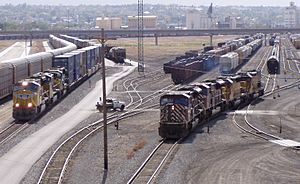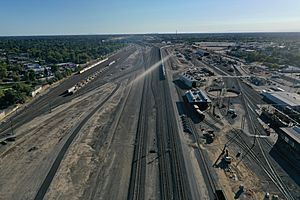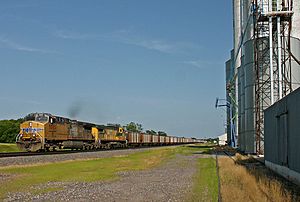Union Pacific Railroad facts for kids
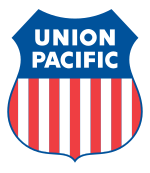 |
|
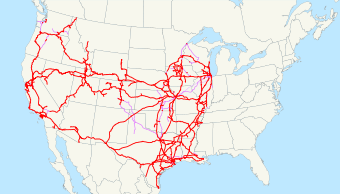
System map (trackage rights in purple)
|
|
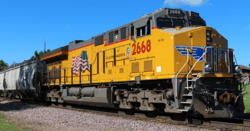
UP 2668, a GE ET44AH, photographed in June 2016
|
|
| Overview | |
|---|---|
| Parent company | Union Pacific Corporation |
| Headquarters | Union Pacific Center at 1400 Douglas Street, Omaha, Nebraska |
| Reporting mark | UP (road locomotives), UPP (passenger cars), UPY (yard locomotives) |
| Locale | Western, Midwestern and Southern United States |
| Dates of operation | 1862–present
|
| Technical | |
| Track gauge | 4 ft 8 1⁄2 in (1,435 mm) standard gauge |
| Length | 32,100 miles (51,700 km) |
The Union Pacific Railroad, often called simply Union Pacific, is a huge company that moves goods by train. It uses 8,300 locomotives (train engines) and runs on 32,200 miles of tracks. These tracks stretch across 23 states in the western, midwestern, and southern parts of the United States.
Union Pacific is the second largest railroad in the U.S. It shares the job of moving freight across the country with another big railroad, BNSF.
The company started in 1862 as the Union Pacific Rail Road. It was a key part of building the first transcontinental railroad, which connected the East and West coasts of America. Over many years, Union Pacific grew by joining with other railroad companies. Today, it is part of the Union Pacific Corporation and has its main office in Omaha, Nebraska.
Contents
History of Union Pacific Railroad
Building the First Transcontinental Railroad
The first Union Pacific company started on July 1, 1862. This was during the American Civil War. President Abraham Lincoln approved a law to build a railroad from the Missouri River to the Pacific Ocean. This was important for keeping the country together.
The railroad was built westward from Council Bluffs, Iowa. It was planned to meet the Central Pacific Railroad line, which was building eastward from Sacramento, California. Most of the workers who built the Union Pacific line were Irish immigrants. They had learned their skills during the Civil War.
The two lines met at Promontory Summit, Utah, on May 10, 1869. This was a very important day because it created the first railroad that went all the way across North America! This combined line became known as the First transcontinental railroad.
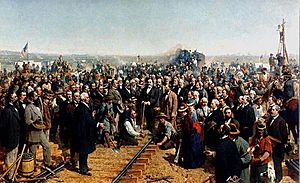
After this, Union Pacific bought other smaller railroads. This helped them extend their reach to places like Salt Lake City and into Idaho.
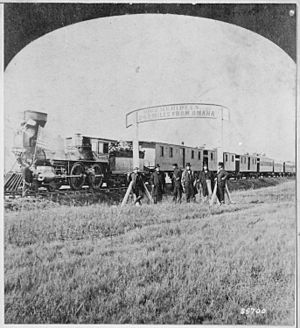
In the 1870s, the original Union Pacific company faced a big problem called the Crédit Mobilier scandal. A construction company that built parts of the railroad charged too much money. Some important people in the railroad company were involved. This caused financial trouble, but the company did not go out of business.
In 1880, a new company bought the old one. This new company was owned by Jay Gould. He combined it with another railroad he owned, and the company's name changed to "Union Pacific Railway." This new company continued to grow, building lines towards Portland, Oregon, and into Colorado and Texas.
However, the Union Pacific Railway also faced financial problems later on. In 1893, it went bankrupt. After this, the company was reorganized, and its name changed back to "Union Pacific Railroad."
Union Pacific in the 20th Century
In the early 1900s, Union Pacific focused on making its existing lines better. They worked with a rival company, Southern Pacific, to create a special system for moving fresh fruits and vegetables. This led to the creation of Pacific Fruit Express in 1906. This company became the biggest renter of refrigerated railcars in the world.
To make train travel faster, Union Pacific built a new shortcut in 1904 called the Lucin Cutoff. This new route was straighter and had fewer hills. The old, curvy route was later taken apart during World War II to get metal for the war effort.
During the Great Depression, Union Pacific wanted to attract more customers. The company's chairman, W. Averell Harriman, decided to improve their trains and make their travel destinations more appealing. They bought the first streamlined train, called the M-10000. They also opened the Sun Valley ski resort in Idaho in 1936. Even though they were early to use diesel engines, Union Pacific kept using steam locomotives for a long time. Their last steam locomotive was delivered in 1944.
As the 20th century ended, Union Pacific realized it needed to become a much larger railroad to survive. In the 1980s, it bought several other railroads, including the Missouri Pacific Railroad and the Western Pacific Railroad. By 1993, Union Pacific had doubled the size of its rail system.
In 1995, Union Pacific joined with the Chicago and North Western Transportation Company. Then, in 1996, it merged with the Southern Pacific Transportation Company. This made Union Pacific one of the two largest railroads in the western U.S.
Railroad Facilities
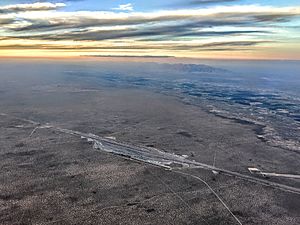
Union Pacific has hundreds of yards where trains are sorted and freight is handled. Most of these are "flat yards" used for local switching. Other types of yards include "intermodal terminals" and "hump yards."
Intermodal terminals are places where freight can be easily moved between trains and trucks or ships. Union Pacific has inland terminals for transfers to trucks, like the one in San Antonio or the one in Santa Teresa, New Mexico.
Hump Yards
Hump yards are special places where trains are sorted using a small hill, or "hump." Cars are pushed over the hump and then roll down into different tracks. In 2006, Union Pacific had 11 major hump yards, including:
- Bailey Yard in North Platte, Nebraska
- Davis Yard in Roseville, California
- Englewood Yard in Houston, Texas
- West Colton Yard in Bloomington, California
More recently, Union Pacific has started using fewer hump yards. They are moving towards a system called "Precision Scheduled Railroading." This means they try to move trains more directly, so fewer yards are needed for sorting.
Facts and Figures
At the end of 2007, Union Pacific had over 50,000 employees. They also owned 8,721 locomotives and 94,284 freight cars.
Their freight cars included:
- 35,437 covered hoppers (for grain, etc.)
- 12,272 boxcars (for general goods)
- 18,647 open-top hoppers (for coal, gravel)
- 13,780 gondolas (for scrap metal, lumber)
- 14,148 other types of cars
Union Pacific also owns 6,950 pieces of equipment used to maintain its tracks. In 2019, Union Pacific was ranked 134th among the largest U.S. companies by revenue. The president of Union Pacific since 2015 is Lance Fritz.
Passenger Train Services
Commuter Services
When Union Pacific bought the Chicago & North Western in 1995, it took over some commuter train services in the Chicago metropolitan area. These are the UP/North, UP/Northwest, and UP/West lines. These trains are branded as Metra services and use Metra equipment. However, Union Pacific crews still operate these trains.
Past Passenger Services
From 1869 to 1971, Union Pacific ran its own passenger trains on its "Overland Route." These trains traveled between Chicago and Omaha. The last long-distance passenger train operated by Union Pacific was the City of Los Angeles, which arrived in LA Union Station on May 2, 1971. Since then, Union Pacific has allowed Amtrak trains to use its tracks for passenger service.
Trains Hosted by Union Pacific
Many Amtrak and commuter rail routes use Union Pacific's tracks. This helps people travel across the country.
Environmental Efforts
Union Pacific has worked on ways to be more environmentally friendly. In 2007, they worked with the US EPA (Environmental Protection Agency) to find ways to reduce pollution from locomotive exhaust. They found that adding a special filter to diesel engines and using cleaner fuel could greatly reduce harmful emissions.
The company also has a "Fuel Master" program. This program rewards train engineers who save the most fuel each month. This program has saved the company a lot of money and helps the environment.
Union Pacific has faced some environmental challenges, including issues with pollution from old rail yards. They are working with environmental agencies to study and clean up these areas.
EMP (Equipment Management Pool)
Union Pacific is a big partner in EMP, which stands for Equipment Management Pool. This is a service that rents and moves over 35,000 large 53-foot shipping containers and their chassis (frames with wheels) across North America. Other railroad companies are also partners in EMP.
Union Pacific Railroad Museum
The Union Pacific Railroad Museum is located in Council Bluffs, Iowa. It used to be a library. The museum shows the history of the railroad and how it helped develop the American West. It has many interesting items, photographs, and documents. You can see old weapons, things that immigrants carried, and a huge collection of over 500,000 photos.
Images for kids
-
Union Pacific locomotive GE AC4400CW #5645 in Battle Creek, Michigan, with the Flags and Flares paint scheme.
-
Union Pacific #5391, approaching a bridge at Multnomah Falls, Oregon, showing the white-outlined blue "wings" on the front.
-
Union Pacific #6419, in Checotah, Oklahoma, with the Flags and Flares paint scheme leading a train on June 26, 2021.
See also
 In Spanish: Union Pacific para niños
In Spanish: Union Pacific para niños
- Central Pacific Railroad
- First transcontinental railroad
- Hell on Wheels (TV series about Union Pacific in 1865)
- History of rail transportation in California
- Kansas Pacific Railway
- Los Angeles and Salt Lake Railroad
- Missouri–Kansas–Texas Railroad
- Missouri Pacific Railroad
- Oregon Railroad and Navigation Company
- Oregon Short Line
- Pacific Fruit Express
- Railex
- Southern Pacific Transportation Company
- Sun Valley, Idaho
- Western Pacific Railroad


